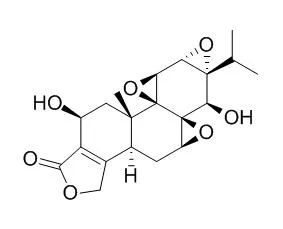| Structure Identification: |
| Phytochem Anal. 2008 Jul-Aug;19(4):348-52. | | Determination of tripdiolide in root extracts of Tripterygium wilfordii by solid-phase extraction and reversed-phase high-performance liquid chromatography.[Pubmed: 18288676] | Extracts of Tripterygium wilfordii Hook F. have been widely used in China to treat a variety of autoimmune and inflammatory diseases. The diterpenoids triptolide and Tripdiolide are two major active components in the T. wilfordii ethyl acetate extract. An efficient solid-phase extraction and high-performance liquid chromatography (SPE-HPLC) method to measure triptolide content in the extract has been previously reported. However, a suitable means of Tripdiolide quantification is not available because of interfering compounds in the extract that co-elute with Tripdiolide. Therefore, this paper describes a method wherein Tripdiolide content can be measured from a small amount of the extract.
METHODS AND RESULTS:
The extract solution (600 microL) was applied into an aminopropyl SPE tube. Triptolide was eluted with dichloromethane:methanol (1 mL, 49:1 v/v), followed by Tripdiolide elution with dichloromethane:methanol (3 mL, 17:3 v/v). The Tripdiolide eluate was analysed by HPLC using an isocratic solvent system and was quantified by measuring the peak area at 219 nm. The contents of triptolide and Tripdiolide in the extract were determined to be 807.32 +/- 51.94 and 366.13 +/- 17.21 microg/g of extract, respectively. Since Tripdiolide is biologically active and makes up a considerable portion of the extract, for extract quality control and standardisation purposes, it should be measured along with triptolide using the proposed SPE-HPLC method. | | Phytochemistry. 2007 Apr;68(8):1172-8. | | Anti-inflammatory and immunosuppressive compounds from Tripterygium wilfordii.[Pubmed: 17399748] | The extract of Tripterygium wilfordii Hook F. (TwHF), which showed anti-inflammatory and immunosuppressive activities in human clinical trials for rheumatoid arthritis, was subjected to the activity-guided fractionation and spectroscopic characterization of bioactives.
METHODS AND RESULTS:
A tetrahydrofuran lignan, tripterygiol (1), and eight known compounds, all capable of suppressing pro-inflammatory gene expression were identified. Most of the pharmacological activity of the extract can be attributed to triptolide, its most abundant and active component, with some contribution from Tripdiolide. | | Can. J.Chem., 1981, 59(17):2677-83. | | Cytotoxic diterpenes triptolide, tripdiolide, and cytotoxic triterpenes from tissue cultures of Tripterygium wilfordii[Reference: WebLink] |
METHODS AND RESULTS:
Plant tissue cultures of Tripterygium wilfordii Hook F produced the cytotoxic diterpene triepoxides Tripdiolide (1) and triptolide (2) in yields that were 16 and 3 times greater, respectively, than those observed in the plant itself. Other diterpenes, dehydroabietic acid (3) and 15-hydroxy-18-norabieta-3,8,11,13-tetraene-3-oic acid methyl ester (4) were also isolated. Co-occuring in these cultures were the cytotoxic quinone-methides, celastrol (5), compound 6, and compound 7. Other triterpenes produced were oleanolic acid (8) and polpunonic acid (9). β-Sitosterol (17) was also isolated. The proposed structure of 4 was confirmed by synthesis starting from compound 3.
CONCLUSIONS:
Cytotoxic data are reported, and a possible biosynthetic relationship among dehydroabietic acid, compound 4, and Tripdiolide (1) is presented. |
|






 Cell. 2018 Jan 11;172(1-2):249-261.e12. doi: 10.1016/j.cell.2017.12.019.IF=36.216(2019)
Cell. 2018 Jan 11;172(1-2):249-261.e12. doi: 10.1016/j.cell.2017.12.019.IF=36.216(2019) Cell Metab. 2020 Mar 3;31(3):534-548.e5. doi: 10.1016/j.cmet.2020.01.002.IF=22.415(2019)
Cell Metab. 2020 Mar 3;31(3):534-548.e5. doi: 10.1016/j.cmet.2020.01.002.IF=22.415(2019) Mol Cell. 2017 Nov 16;68(4):673-685.e6. doi: 10.1016/j.molcel.2017.10.022.IF=14.548(2019)
Mol Cell. 2017 Nov 16;68(4):673-685.e6. doi: 10.1016/j.molcel.2017.10.022.IF=14.548(2019)